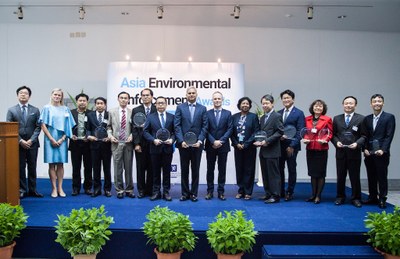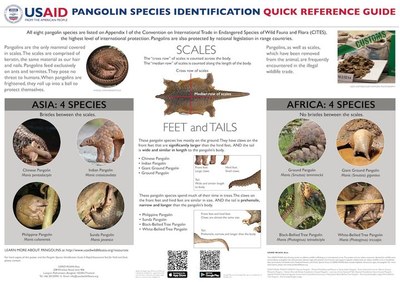USAID Pangolin Species ID Guide Proves Crucial in Pangolin Protection
On April 3, 2019, acting on reliable tip-offs, Singaporean authorities discovered bags containing 12,900 kgs of pangolin scales hidden in a cargo of frozen beef in transit from Nigeria to Vietnam. The high volume of pangolin scales involved in this record seizure, described by conservationists as the “largest single-seizure of pangolins” on record -- was unprecedented.
For Dr. Adrian Loo, Group Director for Conservation and Wildlife Management at Singapore’s National Parks Board (NParks), it was nothing short of “heartbreaking from the conservation point of view”. NParks is the Singaporean government agency mandated to take enforcement action against illegal wildlife traffickers, and investigate cases of endangered or vulnerable species transiting Singapore.
Using the USAID Pangolin Species Identification Guide, Dr. Loo and his team quickly identified the scales to have come from four African pangolin species -- the White-Bellied Tree Pangolin, Black-Bellied Tree Pangolin, Temminck’s Ground Pangolin and Giant Ground Pangolin – classified as either Endangered or Vulnerable by the International Union for Conservation of Nature (IUCN). Developed by the recently completed USAID Wildlife Asia project, the Guide was launched in February 2018 and is available for download through an online portal and as a smartphone application in 10 languages: English, Chinese, French, Portuguese, Malay, Thai, Vietnamese, Lao, Khmer, and Indonesian. Large format identification posters were also produced which are also available via the online portal.
Since the Guide was launched, USAID’s pangolin identification materials have been included in the Convention on International Trade in Endangered Species of Wild Fauna and Flora (CITES) Checklist and Species+ websites, and widely made available to its 183 Member States. USAID’s work on developing the guidebook was commended by the CITES Conference of Parties (CoP) 18 for filling a crucial gap in the protection of pangolins. The Pangolin Species Identification Guide has since been printed and distributed to relevant government offices in Southeast Asia such as Customs, Forestry, Agriculture and Rural Development, Border Control, and the Environmental Police.
“The Guide gave us a quick preliminary identification of what pangolin species could be present in the seizures. It provided the geographical distribution of the four African pangolin species that were seized, giving us an insight on the possibility of pangolins being poached from different areas of Africa,” said Dr. Loo.
This eventually helped the law enforcement agencies build strong cases, which led to 14 suspected members of a criminal syndicate being arrested and prosecuted later on by Chinese authorities.
“The USAID Guide also helps us in our outreach efforts through media and stakeholders such as educators and students,” Dr. Loo added. 
Pangolins, also known as scaly anteaters, are the most trafficked animals in the world. With their populations declining alarmingly, international commercial trade in all eight pangolin species is prohibited under CITES. Despite tis, pangolin seizures were still at an all-time high world-wide in 2019, with more than 155,795 kgs of scales and meat intercepted globally. The island nation of Singapore, one of the world’s busiest hubs, accounted for nearly a fourth of these seizures, with a total of 37,500 kgs of pangolin scales (amounting to US$126 million) intercepted on three separate occasions in 2019. An estimated 42,000 pangolins from four African species were estimated to have been killed for these shipments.
The high volume of shipments points to the involvement of organized criminal syndicates trafficking in wildlife products from Africa to Southeast Asia. In all of these seizures, authorities also discovered bags of ivory in the shipments, again highlighting the involvement of sophisticated syndicates that work across products with different end markets, as ivory is primarily used for decoration and pangolin scales are used in traditional medicine despite their dubious medicinal value.
The illegal wildlife trade, estimated at over $20 billion annually, is the fourth largest illegal trade behind drugs, human trafficking, and counterfeiting. Criminal networks exploit natural resources like timber, fish, and wildlife, fueling global illegal trade and jeopardizing the region’s security and economic development. Moreover, the wildlife trade—including animal markets—opens the door to zoonotic diseases, with pangolins considered as a highly likely source for future pandemics. USAID Reducing Demand for Wildlife follows through on USAID Wildlife Asia’s successes in helping to prevent future pandemics by disrupting wildlife trafficking and expanding targeted wildlife demand reduction campaigns.#


